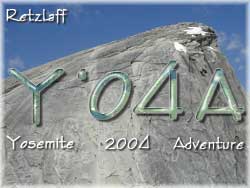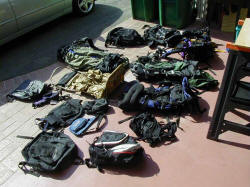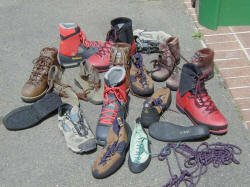|
I am starting to get questions about when we are starting the climb on Saturday morning. First let me say that I have intentionally waited until you are fully committed to give you the good news. Sunrise in Yosemite on Saturday the 22nd is at 5:43 and we get to see it (it will get dark 15 hours later). Plan to be in the trailhead parking area ready to start walking at 5:30. There is no place open for food or drinks that early so plan accordingly. The Trailhead parking lot is about 600 yards south east of Curry Village (see the Valley Floor Map). I plan to drive and park there Saturday morning. As there is no bus service until 7:00 there is no way to get any closer to the trail head to begin our climb. Itís a good warm up walk from the trailhead parking lot to the Trailhead, far less than a mile on flat pavement. We always like to take a group picture (for the search and rescue people) at the sign that announces the official beginning of the John Muir Trail and the route to Half Dome (clothing samples for the bloodhounds are optional). After a brief (we hope) inspirational speech about proper hydration and foot care by ďBig JohnĒ we will fall in and head out. Then itís up, up and away. As this group is so large and there are too many of you to keep track of I wonít try. If you want to walk ďwithĒ us be there on time. This is an ďat your own risk, at your own pace and at your own pleasureĒ event.
Bring duct tape. I forgot to mention this earlier and thought of it only recently. It is the best cure/prevention for blisters. Use it freely if you start to get any hot spots. You can buy small rolls, donít bring 60 yards. We have saved many hikersí feet (and happiness) with the proper and timely application of duct tape. Buy the most expensive kind not the discount stuff. I find the green color to be very pleasing.
It will be cool to chilly first thing in the morning but you wonít want to carry a coat. A fleece is not a bad idea as it can also be windy and cool on top. Avoid sweatshirts; once they get wet they become a useless anchor. If you are planning on going up the Mist Trail you should bring a poncho. www.campmor.com has one for 3.00 that will do the job; they also have an oversized one for 5.00 that is good too. If you already have good lightweight rain gear you are golden. After the mist trail the majority of the climb will be hot and sunny and dry. Assuming no late season blizzards, appropriate summer hiking duds are called for. Donít forget your hat and shades, because we all know that the first rule of any active adventure is that you must always look good, and oh yea be safe too.
As we will be burning up to 5,000 calories on the climb to the top and back, you should plan on replacing 5,000 calories. This climb is not a good weight loss opportunity. Trail mix, snack bars, candy, and dried fruit are my favorites. Any stuff that is light weight and high in carbs/sugar, tastes good and gives energy is good. Also donít forget salty stuff as you will enjoy this late in the day. If you skimp on food you will run out of energy on the way down and you will be most unhappy. We donít abide by grumpy trail partners either. Remember we leave nothing on the trail/ hill; we carry out all trash, peels, cores etc.
There is a chance that the posts that hold the cables off the rock on the final approach will not yet be installed for the season. The NPS normal practice is to have these installed before the Memorial Day Holiday. This practice is really governed by the snow pack and spring weather. We will be there a week before the season officially begins, and may not know until we arrive in the valley if this work has been done. If the cables are not yet ďupĒ the importance of having the right gloves is magnified. Go to the home improvement center near you and buy gloves that have rubber on the palm and fingers. Cotton gloves are terrible and leather are not much better unless they are slightly damp (and your ability to generate enough spit may be limited). The cables are basically slick metal. The better grip you have on them the safer/ happier you will be. Of the many gloves I have used there are two kinds of gloves that I think are the best. The first are the bright orange/yellow polyester mesh gloves with the rubber honeycomb all over. Home depot has them in the garden department. The others that I like are PVC safety gloves. Also can be found at Home Depot online as item number 118316. If you are the daring/ forgetful type there may be some gloves to be found in a pile at the bottom of the cables. The pile might be quite small as we will be ahead of the hoards of summer climbers and because the local fauna supplement their winter diet with those left from last season. Donít let this discussion about the cables worry you. I have done the climb with the cable up and with them down. Each of us will assess the degree of difficulty and our energy reserves when we get there. My experience climbing the rock with the cables down was very enjoyable. Team work really comes into play as it is easier to hold up the cable with more people.
-A pad lock for the bear boxes. This is important. You wonít want to leave any food in your car or take it in the tent cabin with you. -A first aid kit with stuff for blisters and an emergency whistle. -A small flashlight/headlamp. Yes, I have climbed with people who got back after dark. If this happens to you, you would kill for a flashlight. -Sunscreen -Mosquito repellant. Last year we were nearly carried off by the little buggars. They were especially bad near the top as we cross the snow fields in the forest. I guess they like to ski. -Personal radios and cell phone. Fun to call friends from the top and useful too. Cell service is pretty bad on most of the trail but ok at the top. -GPS, mostly for fun and amusement. -Trekking poles can be good if you are used to them. -Many of these items can be shared, so hook up with others. -We have some people who are still looking for lodging; if you have any extra space (even on the floor) and could share it please let me know so that I can hook up those with supply to those with demand (I sound kind of like Greenspan donít you think). -Look for coming attractions: A trail map of the climb. (As soon as I get my new scanner) -Well thatís all for now. Keep training, it will be worth it.
This is an easy one as we will be carrying very little. The heaviest thing will be your water and the bulkiest thing will be your rain coat/ poncho and food. A standard school size book bag type pack is perfect. There are great new packs built just for women that may interest some of you. Although I donít see any packs built just for men so this annoys me. And Professor Higgins did a fine job of representing us (men) when he sangĒ Why canít a woman be more like a man?Ē Notwithstanding my bias against gender specific gear (for women) I have it on good authority that these packs are very suitable for the fairer sex. A 1,500 cubic inch size (plus or minus) is a good target. Fanny packs can work too butt are generally too small. They are quite amusing for the rest of us though. Some people like to use a pack with a built in hydration system. This is good as you tend to drink more if the water is easier to get at. But it can be bad as the water tends to get warmer unless it is the newer insulated type. Itís really a personal preference kind of thing. I donít have/use a hydration system because most of our previous climbs have been too cold for them, when your water supply freezes up itís a bad thing. Check out REI for great packs and all other sorts of gear: http://www.rei.com/ . Donít miss the clearance section.
The hydration system topic is a nice transition to discuss how much water to bring. First letís discuss how much you should plan on drinking. Assuming you are planning on going to the top of Half Dome, and assuming it is going to be a hot day (80+) a large person like me (over 200 lbs.) should drink about 4 liters during the hike. If youíre a diminutive person say less than 150 lbs. then you will probably drink less. It is better to error on the too much side though. Now letís discuss how much water to bring. There is water available in Little Yosemite Valley at the top of Nevada falls. It should be treated/ filtered to avoid John Muirís Revenge symptoms. But this is a nice way to reduce weight going up the mist trail (hundreds of steps). If you start the day with 3 liter bottles and only fill 2 of them, you can stock up at the halfway point, including the extra bottle. This will give you 3 liters for the longer/higher/ hotter part of the hike. Trust me when I say that when you arrive on top of the rock water is more precious than Beluga. We will doubtless see people begging water from anyone with some to spare. Some of these pathetic souls are near collapse. I always like to be the one with a bit extra water, not the dehydrated beggar. Additionally, if you donít hydrate well as we ascend and again on top you will pay the price later in the day as your body revolts against you for mistreatment (this could in fact be a bloody coup). This hike is strenuous enough without getting careless about the simple yet important things. Water can be restocked again on the way down in Little Yosemite Valley. We return on the same trail. If you plan to re-supply on route then you should plan on bringing water disinfectant tablets. Some people drink right from the river but it is not advisable (remember Muirís revenge). Also there are now additional tablets that make the disinfected water taste acceptable to drink. These are very important because if the water tastes like poison you tend not to drink as much and you get dehydrated. REI at http://www.rei.com/ (search for item # 406032) sells a kit for 7 bucks that includes both types of pills. Share these with your fellow team mates. I like to add some Crystal Light as well; it makes me feel like a chemist (mixing all these things together) and makes the concoction mighty tasty (Wolfgang Puck approved and Atkins Friendly).
If you already have some comfy outdoor shoes/ boots for trails or climbing then you should probably use whatís familiar. It can be a big mistake to buy something new just for this trip. If you feel you need to get something new these are my suggestions. It is better to error on the side of too light rather than too heavy. Trail runners are better than mountaineering boots. Now this may be counter to what youíve heard as this is a long hike, and on long hikes you need to project your feet. But if you canít lift you legs the last thing on your mind will be how happy your feet are. Also as you wonít be carrying any real weight you donít need boots that have massive support. I have every imaginable weight of boot in my gear box. From 10 pound double plastic glacier boots to 6 once rock shoes. I will be taking my Rockport Light Tail runners. They are well broken in and good for the long haul. If new shoes are in your future, break them in and bring your receipt with you. We will have 2 prizes for new footwear owners, a prize for the most expensive and one for the least (this could be real fun).
Socks
Donít cheap chicken on the socks. You will need 2 pair of good quality (non-cotton) climbing socks. You should plan on getting very wet on the mist trail (the preferred route). Last year when we climbed in May we were soaked to the toenails. We literally had to ring out our socks (which was handy as we were thirsty). We changed socks and continued. The waterfall was so strong it created its own wind, so we had a torrential horizontal rain/wind storm for an hour. It didnít help that it was 3 in the morning (we thought a night climb to arrive on the top at sunrise would be novel). It was novel but cold and really wet too. To change from damp/wet socks to a pair of dry socks is a true pleasure. Your feet may thank you for weeks. I like mid weight socks for this hike. I like them not for their warmth but for the extra padding. Also buy them a little small. Iíve found them to be very elastic, and they can get too loose on a long day. My personal favorite is Smart Wool brand. I have 15 pair in various weights and styles. I know I should buy stock not socks, but whatever I like them ok? No matter what you do, donít use cotton socks. Yes we will have a sock check before we go. If you attempt to wear cotton you will be publicly ridiculed and the required to sing the Confederate National Anthem (a cappella). As this is where cotton comes from.
|


